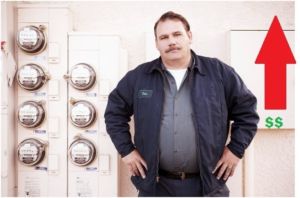MN utility files for huge rate increase to pay for wind and solar
Utilities, regulators and environmentalists make it as difficult as possible to track the real costs of switching over 30 percent of Minnesota’s electrical power generation to wind and solar. Xcel Energy has been claiming its wind turbines will actually save consumers in the long run.
But a newly filed rate increase by Duluth-based Minnesota Power provides rare clarity and proof positive that Minnesotans can expect their electric bills to continue to increase dramatically for the foreseeable future.
The utility wants the Minnesota Public Utilities Commission to grant an 8 percent rate residential rate hike ASAP on January 1. After that? Ten percent more. News accounts say it’s largely due to the enormous cost of upgrading the grid to accommodate the ups and downs of solar and wind generation.
The utility says it needs the money to recover hundreds of millions of dollars invested in its electrical delivery infrastructure in recent years to better deliver a cleaner mix of energy to its customers.
“It’s really recovering the investment we’d made in our system,” Dave McMillan, Minnesota Power executive vice president, told the News Tribune on Wednesday.
The utility has incurred increased costs to recover from storms and “harden” its portion of the grid against extreme weather events. And the conversion from a 95 percent coal-generated system as recently as 2005 to a now 30 percent renewable system has added to the utility’s investment, said Amy Rutledge, Minnesota Power spokeswoman.
Despite the exorbitant costs of replacing coal with far less reliable renewable sources of power, the northern Minnesota utility actually claims that its customers haven’t been paying enough for their power. But they’re working on that with the 18 percent increase on the table for 145,000 customers, plus huge industrial customers.
The rate increase also will help balance the utility’s current cost recovery system, McMillan said, with Minnesota Power officials saying a recent study showed residential customers currently are paying 35 percent less than the true cost of getting electricity into their homes.
“Every Minnesota Power customer will experience increased rates under our proposal. However, we are asking the (PUC) to start aligning rates more closely with the true cost of providing service,” McMillan said.
Now that it’s too late to reverse the switch from coal, apparently some lawmakers and state regulators are getting nervous.
It’s the first general rate increase request by Minnesota Power since 2009. But it’s likely to raise eyebrows by regulators and customers alike because of its cumulative effect on monthly bills.
The 18 percent request is on top of another 10 percent proposed increase as part of the rate shift Minnesota Power is seeking, under orders from the state Legislature, to lower rates for taconite plants and paper mills.
For Duluth customers, it would be a triple whammy, with the two rate increases added to an increase in the city’s monthly franchise fee charged to Minnesota Power. That’s going up from 1 to 3 percent in 2017.
The rate hike would add $15 to the average residential power bill, in addition to another $10 per month in other utility increases, pushing bills to over $100. Small businesses would be charged nearly $30 more per month on average and wipe out the recent break under consideration for the taconite industry.
Kelsey Johnson, president of the Iron Mining Association of Minnesota trade group, said the new rate hike would more than undo the taconite industry rate cut now being considered. The rate cut would have given taconite operations $13 million in savings each year. But the new rate increase adds $33 million in new costs, Johnson said.
“We think this is an untenable request and we are asking the Public Utilities Commision to reject Minnesota Power’s proposal,” Johnson said. “This is going backwards at a time when we are still trying to recover’’ from the U.S. steel and iron ore industry downturn that idled many Minnesota operations.”